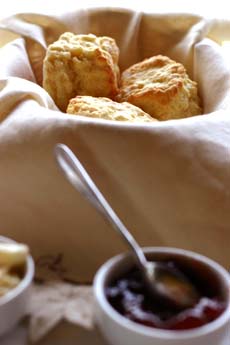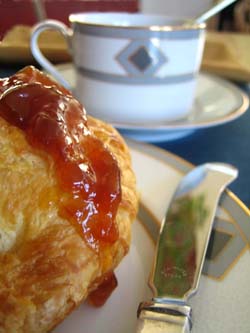

When it’s time to reach for the jam, reach for the best. We nibbled our way through dozens of artisan-made jams to find them for you. Photo by N. Joy Neish | BSP.
|
STEPHANIE ZONIS is a contributing editor.
|
|
June 2006
Updated December 2008
|
 |
The Best Strawberry Jams & Preserves
Page 1: A Berry, Berry Good Overview
CAPSULE REPORT: Just nine flavors account for 80% of all jam and jelly sales in the U.S.; strawberry is the most popular flavor of jam. Seeking a finer alternative to the Smuckers and other commercial jams of our youth, we started with a long list of artisanal jam producers to investigate. Just because a company is a boutique producer doesn’t necessarily make its products better than a mass-marketed one; but we did find more than 17 strawberry jams worth your attention and space in your refrigerator. This is Page 1 of a seven-page article. Click on the black links below to visit other pages.
The earliest known example of a recipe book dates from the first century C.E. The Roman epicure Marcus Apicius, the author, included recipes for fruit preserves, but it is likely that preserves had been around for far longer. There is debate about this, but most sources accept that the custom of extending the life of fruits by cooking them with a sweetener originated in the Middle East, where cane sugar grew naturally. It is thought, too, that Crusaders returning to Europe introduced fruit preserves there; preserves were popular by the late Middle Ages and sometimes served as a dessert all by themselves. Europeans settling in the New World brought their cooking practices with them, and jam-making was known in what would later become the U.S. before the end of the 1600s. In an era when cane sugar was a luxury item (if it could be had at all), settlers used what they could to sweeten preserves of fruit—usually honey, maple syrup or molasses.
Fast forward to the modern era. Americans, known for having a sweet tooth, now consume 4.4 pounds per person per year of what the industry calls “fruit spreads.” Retail sales of jams, jellies, preserves and related products are more than $630 million dollars per year, according to the International Jelly and Preserve Association. That’s a lot of morning toast! The single most popular flavor of jam is strawberry, while grape reigns supreme among jellies. Just nine flavors of jams and jellies account for 80% of all sales.
Our goal was to find the best of the specialty brands of strawberry jam and preserves (jellies and fruit butters were not part of our search, nor were products sweetened with concentrated fruit juices or fruit syrups, commonly referred to as “fruit spreads”). Our intention was to omit low-sugar strawberry jams and preserves, but, rather surprisingly, the FDA has no legal standards for such products, so it wasn’t always possible to determine in advance that a strawberry jam or preserve was low in sugar. No jams or preserves labeled as “low sugar” or “reduced sugar” were tested, but some of the products evaluated were unquestionably lower in sugar than many others. (Apart from the category of “low sugar” products, the finer a preserve (i.e. the more and better the quality of the fruit in it), the less sugar is required to sweeten it.
|

Jam from Tea Together. Click here for our full review of the Tea Together line. Photo by Melody Lan | THE NIBBLE. |
As only a few flavors dominate in the U.S., so, too, do a handful of companies rule the roost in sales and brand recognition. Any grocery or convenience store offers these mass-marketed products, and we all know their names—most of us grew up eating them. But readers of THE NIBBLE know that there are always a host of small producers making jams, jellies and preserves in small batches, many using artisanal techniques, sometimes offering flavors far removed from the everyday. Just because a company is small doesn’t mean it turns out superior products, but some of them do. We started with a long list worth investigating, focusing our search mostly on domestic artisanal producers.
Continue To Page 2: The difference Between Jam, Preserves, Jelly, Etc.
Go To The Article Index Above

|





